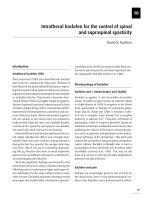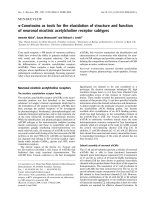Intrathecal baclofen for the control of spinal and supraspinal spasticity
Bạn đang xem bản rút gọn của tài liệu. Xem và tải ngay bản đầy đủ của tài liệu tại đây (168.57 KB, 12 trang )
10
Intrathecal baclofen for the control of spinal
and supraspinal spasticity
David N. Rushton
Introduction
Intrathecal baclofen (ITB)
Penn and Kroin (1985) first described the benefits
that could be obtained by long-term infusion of
baclofen into the spinal subarachnoid space, report-
ing the treatment of six patients with severe continu-
ingspasticityandspasmsresultingfromspinalinjury
or multiple sclerosis. They found a dramatic dose-
related benefit which was highly valued by patients.
Patients reported functional improvements in their
activities of daily living (ADLs), reduced discomfort,
improvement in sleep patterns, continence and noc-
turia. Voluntary power did not necessarily improve,
but one patient in the initial series was enabled to
walk provided that the dose was carefully titrated.
Control of her spasticity and spasms was needed,
but some lower limb tone had to be retained.
Penn and Kroin found that the optimum dose var-
ied widely and that the effects were strongly dose-
related. There was some evidence of drug tolerance:
during the first few months, the average daily dose
rose from 100 to 150 g to something approach-
ing 500 g. Because they were so much improved,
patients were unwilling to take part in controlled tri-
als involving placebo infusions.
All of the significant findings put forward in this
initial report have been amply confirmed during the
following years, in subsequent larger and longer tri-
als undertaken by the same authors and in many
other centres. The initial and many subsequent trials
were open; but double-blind, randomized, placebo-
controlled trials of ITB have more recently been con-
ducted in spinal spasticity and have reported a sim-
ilar magnitude of benefit (Ordia et al., 1996).
Pharmacology of baclofen
Baclofen and ␥-amino butyric acid (GABA)
Baclofen is agonist to the bicuculline-insensitive
variety of GABA receptor known as GABA-B. There
is a high density of GABA-B receptors in the dorsal
horn, particularly in laminae II (substantia gelati-
nosa) and III. Unlike the GABA-A receptor, GABA-
B is not a complete ionic channel but is coupled
indirectly to calcium (Ca
2+
) channels. Activation of
presynaptic GABA-B receptors therefore causes an
inhibition of calcium-mediated inward current, thus
inhibiting the release of excitatory neurotransmit-
ters such as aspartate and glutamate in the polysy-
naptic pathways of the dorsal horn. This alters and
reduces the excitability of monosynaptic and polysy-
naptic reflexes. Baclofen is thought also to exert a
postsynaptic action, which also acts to reduce reflex
excitability (Azouvy et al., 1993). This may be the
basis of its action in reducing H-reflex amplitude in
patients with spinal lesions.
Baclofen and pain
Perhaps not surprisingly, given its site of action in
the dorsal horn, there is also pharmacological evi-
dence that baclofen exerts antinociceptive effects.
181
182 David N. Rushton
These are not mediated by opiate receptors and are
not antagonized by naloxone. There is evidence of a
carbamazepine-like suppression of excitatory neu-
rotransmission in the cat trigeminal nucleus, and
baclofen has been used successfully in the clini-
cal treatment of trigeminal neuralgia (Fromm et al.,
1992).
Pharmacokinetics of intrathecal baclofen
Baclofen in cerebrospinal fluid (CSF)
Baclofen is hydrophilic and crosses the blood–
brain barrier poorly. Spinal intrathecal administra-
tionbypassesthe blood–brain barrier, allowing effec-
tive treatment of spasticity with a dose range that
is 100 to 1000 times smaller than that required for
oral treatment. It also allows a higher baclofen con-
centration to be achieved in the spinal cord than in
the brain because of the characteristics of the cir-
culation of the CSF from the ventricles to the spinal
subarachnoid space. The effective distribution vol-
ume of intrathecally administered baclofen approx-
imates to the volume of spinal CSF (about 75 ml)
rather than total CSF volume. This is one reason why
more effective treatment of spasticity of limbs and
trunk is possible through this delivery route, with
fewer side effects resulting from central actions of
baclofen on the brain.
Localization of ITB
Whenthedelivery cathetertipis placedatupperlum-
bar level, the concentration of baclofen in the lumbar
CSF is several times higher than at the cervical level
(Kroin & Penn, 1992), so it is possible preferentially to
address spasticity focal in the lower limbs. Neverthe-
less, there is some mixing of spinal CSF, particularly
with activity, while baclofen, being hydrophilic, pen-
etrates spinal cord tissue slowly. The response there-
fore always extends much more widely than the level
of the catheter tip. The clinical response to a bolus
infusion or injection of baclofen suggests that the
drug takes about 1 to 2 hours to diffuse to the rele-
vant layers in the dorsal horn of the cord.
Excretion of ITB
The plasma levels of baclofen in patients undergoing
intrathecal infusion have been found to be vanish-
ingly low (Muller et al., 1988). This is simply because
the quantity used is so small; intrathecal baclofen,
like orally administered baclofen, is not metabolized
but is mainly excreted unchanged in the urine.
Neurophysiological effects of ITB
Spasticity score
ITBreducesspasticity,asclinically assessed using the
Ashworth scale (Bohannon & Smith, 1987). ITB has
been found to result in a diminution of 2 points or
more in Ashworth scores in spasticity of both spinal
and supraspinal origin (discussed below).
Spasm score
Flexion or extension spasms, more common in the
lower limbs, may occur spontaneously or in response
to cutaneous stimuli in association with spasticity.
They may be painful and are likely to be aggravated
by any local source of discomfort. The clinical spasm
frequency score is a 5-point scale of self-reported
spasm frequency. It has been shown to respond in a
dose-related and predictable way to ITB (Penn et al.,
1989).
Flexion reflex excitability
The threshold of the electrically induced flexion
reflex in the lower limb (stimulate sural nerve, record
from biceps femoris using electromyography) has
been found to be reduced in spinal spasticity and the
response amplitude to be increased. The response
was normalized in some cases with ITB, a change
that did not necessarily correlate with changes in
Ashworth or spasm frequency scores (Parise et al.,
1997).
Intrathecal baclofen for the control of spinal and supraspinal spasticity 183
Anterior Horn Cell Excitability
The effect of ITB on anterior horn cell excitability
in spasticity has been assessed using F-wave ampli-
tude as an index. The F-wave is usually of low thresh-
old, increased amplitude and increased duration in
spasticity. Latency is not significantly abnormal. The
abnormality of F-wave amplitude and duration was
found to be reduced by 40% to 80% following ITB,
either as a bolus or as a continued infusion (Dres-
sandt et al., 1995).
Effects of ITB on function and quality of life
Functional independence measure (FIM)
In one study (Albright et al., 1995), average FIM
scores rose during the postimplantation follow-up
period by 18 points. In those with good upper limb
function, the rise was larger (25 points) and covered
most of the items apart from ‘eating’ and ‘stairs’.
In those with poor upper limb function, the rise
was less (4.8 points) and mainly focused on ‘eat-
ing’ and ‘wheelchair function’. However, comfort was
also improved, nursing made easier and care burden
reduced.
Quality of Life (QoL)
Patients who previously had become institutional-
ized on account of unmanageable spasticity may be
enabled to return to live in the community following
the start ofITB. Admissions with acute medical prob-
lems may be greatly reduced. In one study (Becker
et al., 1995), a group of patients who between them
had spent 755 days in acute care hospital during the
year before implantation, spent between them only
259 days in hospital during the year after surgery.
A larger randomized placebo-controlled multicentre
trial of 22 patients (Middel et al., 1997) examined the
response on the sickness impact profile (SIP) and the
Hopkins symptom checklist. After 3 months of ran-
domized placebo-controlled study, all patients were
switched to ITB. After 1 year, there were modest but
significant benefits of ITB on some dimensions of
the SIP (‘mobility’, ‘body care and movement’), and
in health behaviour (‘sleep and rest’, ‘recreation and
pastimes’), but not in psychosocial behavior in com-
parison with the preoperative condition. In progres-
sive diseases such as multiple sclerosis, it may be
particularly hard to demonstrate a sustained benefit
to quality of life, despite a sustained benefit to mea-
sures of impairment, such as spasticity or spasms
(Zahavi et al., 2004).
Cost-benefit analysis
There are still relatively few studies of the cost–
benefit impact of ITB. One retrospective review of
17 published studies,including a total of 324 patients
(Sampson et al., 2002) calculated the change in qual-
ity of life and estimated the costs in UK terms from
data given. Depending on the severity of disabil-
ity the cost/QALY for ITB ranged between
£
6900
and
£
12 800, thought to be good value in care-
fully selected patients. No comparison was made
with alternative methods of spasticity management.
Nance et al. (1995), in a small prospective study,
found a net cost saving of over $150 000 in 2 years fol-
lowing implantation, attributable mainly to reduced
hospitalizations. On the other hand, Albright et al.
(1995) made a comparison of ITB and selective func-
tional posterior rhizotomy over 1 year in 19 chil-
dren with cerebral palsy. They showed that the cost
of ITB was nearly four times higher but made no
attempt to compare the efficacy of the two treatment
methods.
Indications and patient screening
tests for ITB
General considerations
ITB may benefit function, comfort or carer burden;
it may help more than one of these, and occasion-
ally it may benefit all three. However, it is an elab-
orate, invasive and expensive form of treatment. It
calls for regularfollow-up for pump refills, which typ-
ically have to be done several times a year. The pump
itself, if it is battery powered and not rechargeable,
184 David N. Rushton
has to be replaced every 5 to 6 years. It is therefore
fortunate that only a minority of patients with spas-
ticity require ITB. Which ones are they?
Indications for ITB
ITB is used in patients with widespread spasticity
in whom alternative methods of spasticity manage-
ment are ineffective or inadequate or cause unac-
ceptable side effects. In all patients with spastic-
ity, remediable aggravating factors such as urinary
retention or infection, skin infection or pressure
sores, uncomfortable seating and poor posture will
have been addressed in their own right. Passive
muscle stretching, active physiotherapy, hydrother-
apy and active exercise are all important aids to
controlling and minimizing spasticity, particularly
during the stage when spasticity is developing.
Oral antispastic drugs such as baclofen, dantrolene,
diazepam or tizanidine will have been introduced
and titrated to find the optimum drug combination
and dose range. This leads to a protocol wherein ITB
is considered only in those patients in whom severe
spasticity has developed in spite of preventive mea-
sures and who cannot be controlled in any less inva-
sive way.
Alternatives to ITB in widespread spasticity
In many centres dealing with patients with seve-
re spasticity, unselective dorsal rhizotomy and intra-
thecal phenol as treatments for spasticity have been
largely supplanted by ITB. Unselective rhizotomy
often results in significant loss of sensory function,
and nonreflex stiffness and spasms may supervene.
The effects of intrathecal phenol are found to be
unpredictable in all but the most experienced hands,
and it can be used only in patients who have already
lost bladder and bowel control. Selective posterior
rhizotomy has been used extensively in some centres
for thetreatmentof spasticity,particularly incerebral
palsy. It has been compared with ITB in one cen-
tre and found to be about equally effective; relative
indications for one or the other form of treatment
have been described (Albright et al., 1995). Epidural
spinal stimulator implants have been used, often in
patients who have pain as well as spasticity, although
the efficacy has not been compared with ITB (Baro-
lat et al., 1995). Cerebellar stimulation is sometimes
used in the controlofspasticityandfoundtobeeffec-
tive, particularly in cerebral palsy, but again no com-
parison with ITB for efficacy has been made (Davis,
2000).
Indications for botulinum toxin
Patients whose spasticity is focal and involves acces-
sible muscles will have been offered local treat-
ments such as intramuscular botulinum toxin and
are usually better managed in that way. Some
patients with focal spasticity are managed with
nerve blocks, but neurodestructive injections are
much less used now that botulinum toxin is widely
available.
Trial dose
A trial dose of intrathecal baclofen is done for two
reasons. First, it is necessary to demonstrate that
ITB will make a significant impact on the level of
spasticity and spasms. Secondly, it is necessary to
demonstrate that it will, as a result, significantly ben-
efit function, comfort, posture, care or hygiene. In
order to achieve these demonstrations, the patient
must be taken through a functional assessment
as well as bedside tests of tone and spasms. The
patient must therefore be mobilized, into walking
or wheelchair as appropriate, during the action of
the single intrathecal dose, which typically lasts
for several hours. The period of bed rest following
the lumbar puncture must therefore be not more
than an hour or so. It is therefore considered to
be advantageous to use as fine a needle as pos-
sible, preferably of the noncutting fibre-splitting
type, so as to minimize the risk of low-pressure
headache.
An initial intrathecal trial dose of 25 or 50 μgof
baclofen is used. The smaller initial trial dose should
be used if the patient is not on oral baclofen, in case
of sensitivity. If the response to the initial trial is
Intrathecal baclofen for the control of spinal and supraspinal spasticity 185
Figure 10.1. Pump pocket location is usually in the anterolateral abdominal wall. Catheter is tunnelled to the lumbar
region and into the spinal canal at lumbar level, turning craniad and terminating at conus level. (From Medtronic Ltd., with
permission.)
inadequate, a second trial dose of 75 or 100 μg can
be given the next day. The maximum single bolus
trial dose recommended is 100 μg. Opinions vary
as to whether oral baclofen should be continued
unchanged through the trial. It is probably better to
do so, on the grounds that to alter it would com-
plicate the assessment; the intrathecal bolus dose
response is in any case a poor guide to titration of
the likely daily infusion rate which will subsequently
be needed.
ITB infusion is often found to improve bladder and
sphincter function and has been found to improve
urodynamic parameters such as bladder capacity,
reflex detrusor contractions, bladder compliance
and detrusor-sphincter dyssynergia. However, any
bladder effects are often difficult to evaluate dur-
ing the time available in the preimplantation trials.
Sometimes it causes sphincteric weakness, resulting
in stress incontinence (Bushman et al., 1993). Vary-
ing effects on erectile and ejaculatory function have
been recorded (Denys et al., 1998).
Implant surgery
After exposing the laminae, the subarachnoid space
is accessed at lumbar level using a Tuohy needle
(Fig. 10.1). Paramedian location of the needle helps
avoid catheter kinking later, as the spine moves. The
catheter is passed up to about T10 vertebral level. It
is screened to ensure that it is not kinked in location.
It is tunnelled through paraspinal muscle, which is
sutured around it to help avoid CSF leakage past the
catheter. The catheter is anchored to prevent slip-
page and is tunnelled through to the selected pump-
pocket location, usually in the right iliac fossa deep
to the external oblique muscle. The guide wire is
removed,andCSFshould oozefromthecatheter. The
catheter is then trimmed to length (with sufficient









